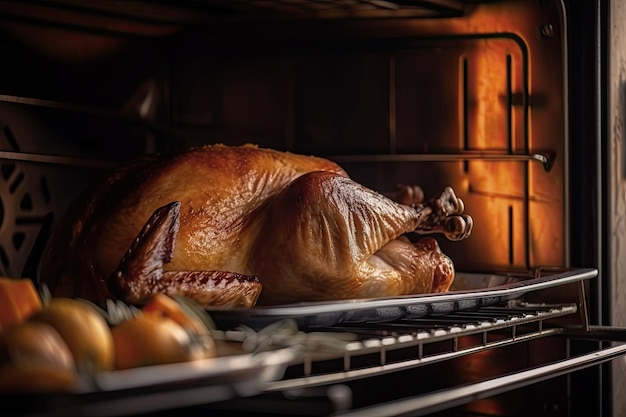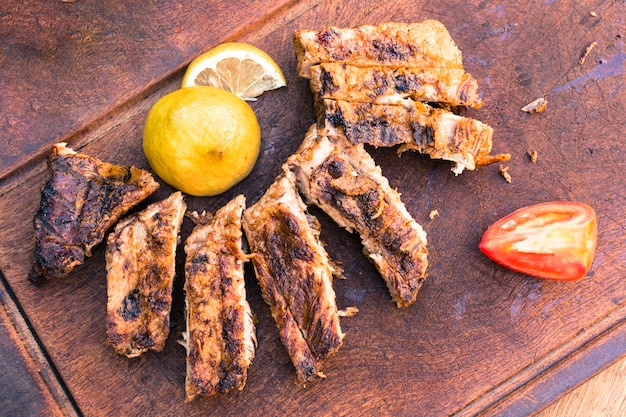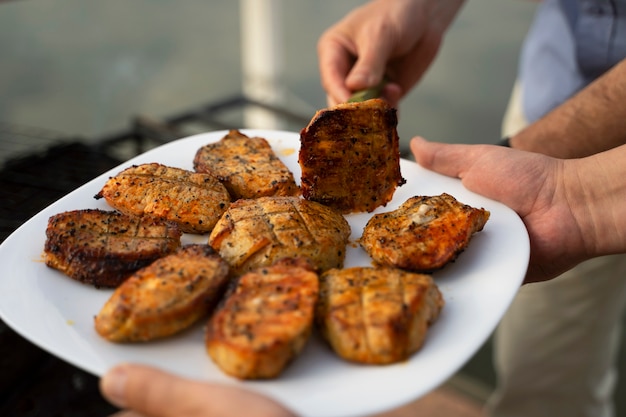You've got the hankering for some seriously delicious ribs, haven't you? Those St. Louis ribs, with their melt-in-your-mouth tenderness and rich, smoky flavor, they're legendary for a reason. But let's face it, getting that perfect cook time down can be tricky. I've been baking ribs for years, trying countless techniques and temperatures, so I'm here to share what I've learned. Grab a pen and paper, because we're about to dive into the nitty-gritty of oven-baked St. Louis rib perfection.
Part 1: The Right Ribs: Choosing Your Prime Cut

The St. Louis Cut: The King of Ribs
Let's start with the star of the show – the St. Louis rib. It's the prized cut, folks. Taken from the belly of the pig, it's got that rich marbling that makes it incredibly juicy and flavorful. We're talking about a bite that's both tender and packed with taste. It's also the most versatile for oven baking, nice and thick for long cooking times, and with plenty of surface area for that rub to really sink in.
Fresh vs. Frozen: A Matter of Preference
Now, you can find ribs fresh or frozen. I personally prefer fresh, but if time is tight, frozen works just fine. Just make sure they're fully thawed before you start, or things are going to get messy. When picking ribs, look for a nice, even red color. Avoid any with a grayish or greenish tinge – that's a sign they're not fresh.
Anatomy 101: A Peek Inside the Rib Cage
Before we move on, let's talk about rib anatomy, because understanding how they're built helps you get those ribs perfectly cooked. A whole rack is made up of individual "bones" connected by cartilage. That cartilage is what makes ribs bendy. When you cook, you're breaking down that cartilage, which is why ribs get so incredibly tender. Think of it as a mini-science experiment!
Part 2: The Rub Down: Layering on Flavor

Building Flavor from the Inside Out: A Rub's Power
Alright, let's get down to the good stuff: the rub. It's what brings that depth and complexity to your ribs, like a secret recipe passed down through generations. There are tons of pre-made rub blends out there, but if you're feeling adventurous, you can absolutely create your own. Experiment and find what you love – there's no right or wrong here!
My Go-To Rub: A Sweet and Savory Symphony
My personal favorite rub is a blend of brown sugar, paprika, garlic powder, onion powder, black pepper, and a touch of cayenne for a little kick. But, sometimes I'll add a sprinkle of chili powder, just because. It's all about flavor, baby!
Rubbing Like a Pro: The Art of Applying Flavor
Now, applying the rub is key. You want it all over those ribs, even between the bones. I like to rub it in with my hands – it feels good and gets the rub evenly distributed. Make sure it's a nice coating but not too thick, as you don't want a layer that prevents the ribs from getting that delicious char.
Part 3: Oven-Baked Perfection: The Slow and Steady Cook

The Prep Work: Getting Ready for the Oven
Alright, your ribs are rubbed and ready to go. Preheat the oven to 300°F (150°C). This is going to be a low and slow cook, so patience is our friend. While the oven is warming, grab a roasting pan – we'll need that soon.
The Rack Setup: A Secret to crispy bark
Now, you can bake your ribs on a rack or straight on the bottom of the pan. I prefer a rack – it helps create a crispy, flavorful bark. Place the rack inside the roasting pan so any drippings don't make a mess in your oven. And those drippings? They're gold, trust me! We'll talk about them later.
The Cook Time: Unlocking Tenderness
This is where the real magic happens. The cook time for St. Louis ribs can vary depending on thickness and how tender you like your meat. For me, it's all about that fall-off-the-bone tenderness. As a general rule, aim for 3-4 hours at 300°F (150°C). But don't just set a timer and forget about it. You need to check those ribs throughout the cooking process.
Part 4: The Monitoring Stage: A Watchful Eye on the Prize
Checking for Tenderness: Ribs Can Be Tricky
This is where experience comes in handy. You can't just throw the ribs in and walk away. Check them every 45 minutes to an hour, at least. How do you know if they're ready? The key is checking the meat for tenderness. If the meat starts pulling away from the bone, you're on the right track. Use a fork to help. If it easily pierces the meat and it feels tender, you're golden.
The Basting Secret: Adding Moisture and Flavor
While those ribs are cooking, don't forget about basting! It's not essential, but it definitely keeps them moist and flavorful. I love using a mix of apple cider vinegar and honey, but you can get creative. Just make sure it's flavorful and helps keep those ribs juicy.
Part 5: The Finishing Touch: A Glaze for Glory
The Glaze: A Final Burst of Flavor
Your ribs are looking good, smelling even better. Now it's time for the grand finale – the glaze. It's what takes them from delicious to extraordinary. A thin, sugary sauce, it caramelizes in the oven, giving your ribs that beautiful glossy finish. It's the final flourish, the cherry on top!
My Glaze Recipe: A Sweet and Smoky Delight
My go-to glaze is super simple: ketchup, brown sugar, Dijon mustard, and apple cider vinegar. The brown sugar brings the sweetness, the Dijon mustard adds a tangy kick, and the apple cider vinegar balances it all out. But feel free to experiment! The key is a glaze that coats the ribs easily but creates a nice caramelized crust.
Applying the Glaze: A Touch of Magic
Less is more when it comes to applying glaze. Just lightly brush it on, don't overdo it. A thick layer will burn. The best time is about 30 minutes before the ribs are done. This gives the glaze time to cook and caramelize, creating that perfect glaze-to-rib ratio.
Part 6: The Resting Period: Let Those Ribs Relax
Why Resting is Essential: Giving the Ribs a Moment to Breathe
Ribs are cooked to perfection, but don't dive in just yet! You need to let them rest. It might seem odd, but it allows the juices to redistribute, making the ribs even more tender and flavorful.
The Resting Process: Tenting and Patience
Cover those ribs with aluminum foil, creating a little steamy environment to keep them moist. Let them rest for at least 15 minutes. While they're chilling, start on those sides. You'll want something good to pair with those ribs.
Part 7: Serving Up the Goods: Getting Ready to Enjoy
The Presentation: Making Your Ribs Look as Good as They Taste
Alright, your ribs are rested, the sides are ready. Now, let's plate these beauties. I like to serve ribs on a platter with some of the leftover cooking juices spooned over top. It adds extra flavor and moisture.
The Side Show: Complementary Sides for Rib Heaven
What to serve with your ribs? The possibilities are endless! I love classic coleslaw, creamy mashed potatoes, or baked beans. But you can also go more adventurous, like a spicy corn salad or a sweet potato casserole. It's all about your taste buds!
Part 8: A Few Extra Tips: Mastering the Art of oven-baked ribs
Temperature Check: Making Sure It's Safe to Eat
One final tip, folks. Before you dig in, check the internal temperature of the ribs. They should reach 145°F (63°C) to ensure they're cooked through and safe to eat.
The Leftovers: The Best Part of the Meal (Almost)
Leftovers, are you kidding me? They're even better the next day. The flavors meld and the meat is even more tender. Reheat them in the oven or on the stovetop and enjoy!
FAQs
1. What if my ribs are a bit dry?
Don't panic! There are a few things you can do to add moisture and flavor. Try adding a bit of extra sauce, or reheat them in the oven with some broth or water.
2. How do I know when my ribs are done?
The best way to tell is by checking the tenderness. The meat should easily pull away from the bone with little effort. You can also use a meat thermometer – they should reach 145°F (63°C) for safety.
3. Can I use a different cut of ribs?
You can, but St. Louis ribs are the most versatile for oven baking. Other cuts may require a different cooking time and temperature.
4. How do I store leftover ribs?
Leftover ribs can be stored in the refrigerator for 3-4 days. Wrap them tightly in plastic wrap or aluminum foil to prevent drying out.
5. What if I don't have a roasting rack?
No problem! You can bake ribs directly on the bottom of the roasting pan. Just spread them out in a single layer so they cook evenly.
Now, go forth and conquer those oven-baked St. Louis ribs. You've got this!
Everyone is watching

How to Cook Frozen Lobster Tails Perfectly: A Step-by-Step Guide
RecipesLobster. Just the word conjures up images of lavish meals, special occasions, and a taste of luxury. But let's...

Pigs in a Blanket Cooking Time: How Long to Bake for Perfect Results
RecipesAh, pigs in a blanket. Just the name conjures up images of those delightful little parcels of crispy pastry en...

Pork Fillet Cooking Time: How Long to Cook It Perfectly
RecipesPork fillet, or tenderloin as it's sometimes called, is a real favourite in our house. It's so versatile, and...

The Ultimate Guide to Tender, Juicy Pulled Pork
RecipesRight, let's talk pulled pork. It's one of those dishes that just screams "comfort food," doesn't it? I mean...

The Ultimate Guide to Cooking Sweet Potatoes: From Roasting to Mashing
RecipesSweet potatoes. Just the name conjures up images of warm, comforting dishes, bursts of vibrant color, and a to...
